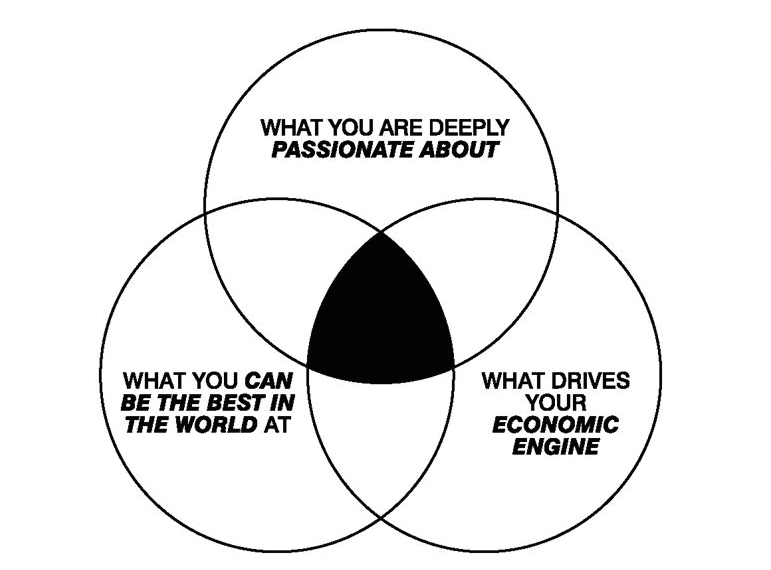Contents
Use the ‘Hedgehog Concept’ to build your mission statement
Use a formula for your mission statement
Choose a type of mission statement
Ensure your mission statement is realistic
Do you raise your eyebrows when someone mentions mission statements? It’s easy to get cynical. Too many companies use bullshit phrases when they write a meaningless mission statements.
Even worse, some mission statements are blatant lies. Take the mission statement of Enron, ‘Our mission is to build unrivalled partnerships with and value for our clients through the knowledge, creativity and dedication of our people’. We all know how that ended. They ended up synonymous with corporate fraud.
And yet, it is possible to craft a well-written mission statement that energises your business. A good mission statement is essential to any purpose-driven business as it acts as a north star, guiding you forward. Without it, you’re likely to get steered off course by working life’s everyday ‘busy-ness’. Not forgetting the twists and turns of clients’ demands.
What is a mission statement?
Definitions for mission statements can get vague, with people disagreeing on what a mission statement should be about. There’s often confusion and overlap between mission statements and a company’s purpose.
We go with the Jim Collins version of life. Your mission statement and your company’s purpose are separate things that, together with core values, make up your strategic vision.
A company’s purpose is entirely focused on why your business exists. People often refer to Simon Sinek, who famously said in his TED talk you should ‘Start with Why’ (although I disagree – far better to ‘Start with Who’. More of that later).
Mission statements are a longer-term thing, 10 to 25 years into the future. They talk about what you’re going to achieve and how you’ll know you’ve achieved it. This makes more sense to me. ‘Mission’ is an active word that implies a destination. ‘I’m on a mission’.
An excellent way to think about the different terminology is the ‘why’, the ‘what’ and the ‘how.’ The ‘why’ is a company’s Purpose. The ‘what’ is a Mission Statement. The ‘how’ is Core Values.
Over time, Jim Collins stopped using the term mission statement, preferring to use BHAGTM or Big Hairy Audacious Goal. This terminology was more emotive, implying a moon shot that could fire people up, inspiring passion, excitement and motivation. Any mission statement or BHAG should make eyes shine and neck hairs prickle.
Use the ‘Hedgehog Concept’ to build your mission statement

When guiding clients toward creating an effective mission statement, I often reference Jim Collins’ work from his best-selling book, ‘Good to Great’.
His approach revolves around what he calls the ‘hedgehog concept’ It’s based on the ancient Greek parable of a fox trying every trick in the book to eat a hedgehog. Collins argues that your company is more likely to succeed if you can identify the one thing you can do best.
It sounds simple, but it takes time to define this, working through three specific areas.
Firstly, I get the leadership team to isolate what gives their company energy and passion. I ask them to work out what gets them out of bed early in the morning and keeps them working late voluntarily.
Secondly, I ask them to define the one thing they can be best at – something they know they can do better than anyone else.
And finally, I get them to examine the things that drive their economic engine in terms of profitability and market potential.
Where these three areas overlap is where they will find a great mission statement. Often, I’ll get each team member to write a mission statement down on a post-it note. It doesn’t need to be word-smithed to perfection. It’s the first stab.
We stick them all up on the wall and, you guessed it. Every mission statement is different! Then I ask the team to reflect – collectively – and choose the most creative idea that embodies the most significant leap of faith. I get them to tune into their emotional reactions – I’m looking for those shining eyes.
This collaborative approach to writing a company’s mission statement can be practical – after all, everyone needs to buy in and sell this new trajectory to the rest of the company.
Know your core customer
Fundamental to any mission statement focus is an in-depth knowledge and understanding of your core or target customer. After all, how can you work out what you’re going to be the best in the world without knowing the target market you’re doing that for?
Your guiding principle should be, ‘Who are the customers that will buy from us at a maximum profit?’
Most of the time, my clients don’t have this. Since they started trading, they’ve attracted many customers, all looking for different things. This makes it hard to narrow down to the core customer fundamental to any mission statement and will ultimately drive company growth.
Perhaps it’s a customer segment that buys the fullest range of services or has the potential to do so. We narrow it down to one person who best represents these customers and build a profile of them – what are they trying to do in their business?
Does this target audience have a transformational challenge? What insights tell their story? How will they feel when they sign on the dotted line?
Use a formula for your mission statement
In his book ‘Business Made Simple’, Donald Miller puts forward a simple framework if you’re starting from scratch on a mission statement. It’s so helpful that I’m using it with clients struggling to work out their mission statements.
The wording runs as follows:
‘We will accomplish ________ (goal) by _________ (deadline) because of __________(foreshadow the stakes).’
The last part refers to what will happen if you don’t achieve your mission statement. It talks to your ‘Who’. We’ll accomplish this great thing; otherwise, our core customers will suffer something or miss out. I love that. It gets companies to think about the impact they can have on their customers.
Take Boeing’s transformation from military to civilian airliners. Using this approach, their mission statement could have been:
‘We will become the world’s largest manufacturer of civilian airliners by 1970 because otherwise, people will never know the freedom of global travel.’
Choose a type of mission statement
Mission statements can vary. The best ones are clear and compelling, requiring little explanation. They break down into four models:
- Target orientated mission statement
These are clearly defined as quantitative or qualitative mission statements. When I’m coaching clients through the process of finding a more comprehensive mission statement, I prefer not to use numbers or quantitative figures.
For example, I was with a new client the other day who said their mission statement was ‘Having 1500 employees in 5 years’. This might be great for the business, but I could imagine their staff yawning.
In many cases, when you put a number in your mission statement, it can take the emotion out. However, our client Smartsourcing has developed a dynamic mission statement containing their company’s goals, ‘To change the lives of 5,000 Philippinos’. A compelling statement. And they will know when they’ve reached that destination.
- Role model mission statement
This type of mission statement mimics the traits of other successful companies outside your sector. It’s something we did brilliantly when I was at Rackspace.
Initially, our mission statement was ‘To be the leading provider of managed hosting services to businesses, while providing Fanatical Support™ to our customers and generating profits’ – a bit wordy. We wanted to make our mission statement more emotional.
We aimed to become the IT equivalent of Ritz Carlton or Nordstrom. They have a fantastic reputation for customer service, and we wanted to bring this to our sector.
So, our new mission statement became “To be recognised as one of the world’s great service companies alongside Ritz Carlton, Lexus and Nordstroms”. Now we were getting somewhere!
- Competitive mission statement
As its name implies, this type of mission statement focuses ruthlessly on your competition. It can work wonders if you need to rally your troops around a common enemy.
Mission statement examples of this type include Nike’s 1960s mission statement to ‘Crush Adidas’ and Honda’s 1970s mission statement, ‘Yamaha wo tsubusu! We will destroy Yamaha’.
- Internal transformation mission statement
If you’re already well established but have an apparent transformational mission, you can focus your new mission statement on that goal.
There are some excellent mission statement examples of transformational mission statements. One of the best is Microsoft’s ‘A computer on every desk and in every home, running Microsoft software.’ It drove the entire company forward, and anyone you met who worked in the business could articulate it.
Ensure your mission statement is realistic
A well-crafted mission statement comes at the end of a great deal of strategy work. You can’t just pluck it out of thin air.
I was interviewing one of the world’s top business thinkers, Roger L Martin, for my Melting Pot podcast recently. Interestingly, he disagreed with me on most of the things we discussed. I love this type of challenging conversation! He said, just because you say something out loud doesn’t mean it will come true.
But I think there’s a balance between a mission statement that’s completely unrealistic and something that might be just within reach. Take our mission statement at Rackspace, ‘To become the Ritz Carlton of IT Services’.
When we wrote this mission statement, we were miles away from being the equivalent of Ritz Carlton. More like Travelodge! But there were glimmers of hope. It was in our DNA to get to that destination.
We could have quickly gone down the route of our competitors – giving up on service and focusing on technology or profit instead. But because it was our mission to excel in customer service, we stuck to it. It guided all our strategic decisions from that moment.
That’s the beauty of a good mission statement. It will make your life easier. Your mission statement serves as a North Star for the voyage of your business – it will steer you into your company’s future and through all the noise. Product Development, Customer Selection, Markets, Geography, and M&A – all are impacted by the mission statement you choose. It’s part of the narrative you’re telling to staff, customers and competitors. So invest time and effort in crafting a good mission statement.

